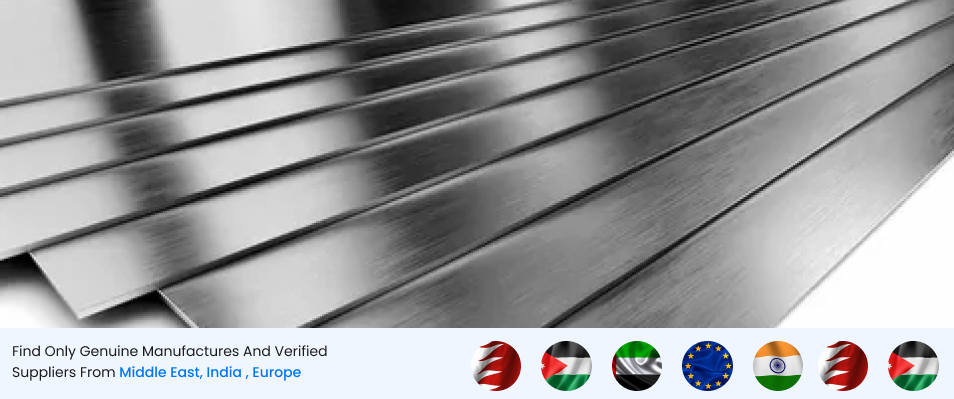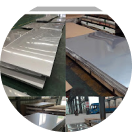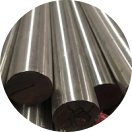
A flat-rolled, very thin sheet of stainless steel. A stainless steel strip is a type of steel that is used in applications that demand a durable, corrosion-resistant material. It is utilized in the building, construction, and manufacturing of residential and commercial kitchen gadgets or equipment.
Stainless steel strips are widely used in industry due to their outstanding corrosion resistance and superior machining capabilities. Automotive, HVAC (heating, ventilation, and air conditioning), chemical, food processing, refrigeration, and construction are examples of typical applications.
Strip steel, i.e. cold-rolled strip, is a steel product made from coated hot-rolled strip. The coil is then immediately reduced using a cold rolling mill with a single shelf or a rotary or tandem mill consisting of several independent shelves in a row.
Name : Stainless steel sheet
Standard : ASTM, AISI, SUS, JIS, EN, DIN, GB, ASME, etc
Austenitic Steel : 301, 304, 304 H, 304 L, 310, 310,316, 316 L, 317, 317 L, 321, 347
Ferritic Steel : 409, 409 M, 410 S, 420, 430
Martens tic Steel : 410, 416, 420, 431
Thickness: 0.3 mm - 100.0 mm
Width: As Required
Length: As Required
Finishes: 2D, 2B, BA
Certification : SGS, BV, ISO, etc
Trusted
Supplier
Genuine
Product
Easy
purchase
Stainless steel strip is often used in industries such as telecommunication, medical, aerospace, construction, automotive, electronics, petrochemical and food processing.
Take the specifications to a qualified professional, such as those listed here on this website, to determine what type of stainless steel band might work best for you. They evaluate critical factors such as the environment in which the tapes are intended to be used (including temperature and weather), the amount of impact the tapes can expect, the strength of the tape needed, and the size of the room in which the tapes will work Quality manufacturers also consider certain standard regulations that stainless steel strips must comply with, such as those issued by FDA, OSHA, ISO, ASME or ASTM International. To find experienced, reliable and trustworthy stainless steel suppliers, please review our list of outstanding organizations.
| Item | Stainless Steel Strip (Hot rolled, cold rolled) |
|---|---|
| Thickness | 0.025 to 3 mm and as per Customer Requirement |
| Width | 3 mm to 2000 mm and as per Customer Requirement |
| Length | 2000mm, 2440mm, 3000mm, 5800mm, 6000mm, etc |
| Standard | JIS, AISI, ASTM, GB, DIN, EN, etc |
| Surface | the surface and finish of stainless steel 201 Strip 2B, 2D, BA, NO.1, NO.4, NO.8, 8K, mirror, checkered, embossed, hair line, sand blast, Brush, etching, etc |
| Brand: | Indian Origin, European Origin, Japanese Origin, US Origin, Korea Origin, Thailand Origin, Taiwan Origin |
| Manufacturer: | POSCO, Aperam, Jindal Stainless, DKC Korea, Thyssenkrup, Baosteel, TISCO, Arcelor Mittal, VDM, Nippon Metal, Outokumpu |
| Package | Shrink-wrapped ,Carton boxes,Wooden pallets,Wooden boxes ,Wooden crates Etc. required. |
| Export to | India, Indonesia, Malaysia, Singapore, Saudi Arabia, Qatar, UAE, Iran, Iraq, Oman, South Africa, Nigeria, Kenya, Italy, UK, Brazil, Russia , Egypt , Kuwait , Taiwan, Australia . |
| Material | Tensile Strength at Break (MPa) | Tensile Strength, Yield (MPa) | Modulus of Elasticity (ksi) |
|---|---|---|---|
| All Stainless Steel | 85.0 - 3000 | 46.8 - 2400 | 10000 - 46000 |
| Precipitation Hardening Stainless | 310 - 3000 | 276 - 2400 | 10000 - 33400 |
| T 300 Series Stainless Steel | 250 - 2200 | 138 - 1800 | 11000 - 31000 |
| T 400 Series Stainless Steel | 280 - 2030 | 165 - 1900 | 10500 - 46000 |
| T 600 Series Stainless Steel | 550 - 1720 | 46.8 - 1590 | 29000 |
| T S10000 Series Stainless Steel | 848 - 2520 | 421 - 2100 | 11200 - 33400 |
| T S20000 Series Stainless Steel | 670 - 1830 | 292 - 1730 | 24800 - 30500 |
| T S30000 Series Stainless Steel | 450 - 1620 | 200 - 1480 | 27600 - 29000 |
| T S40000 Series Stainless Steel | 455 - 1800 | 207 - 1730 | 29000 - 31200 |
| Grade 201 (Annealed) | 792 Min. | 310 Min. | 26600 |
| Grade 202 (Annealed) | 655 Min. | 275 Min. | 28600 |
| Grade 301 (Annealed) | 861 Min. | 275 Min. | 28000 |
| Grade 302 (Annealed) | 655 Min. | 262 Min. | 28000 |
| Grade 304 (Annealed) | 655 Min. | 262 Min. | 28000 |
| Grade 304L (Annealed) | 655 Min. | 262 Min. | 28000 |
| Grade 305 (Annealed) | 620 Max. | 241 Min. | 28000 |
| Grade 316 (Annealed) | 689 Max. | 275 Min. | 28000 |
| Grade 316L (Annealed) | 689 Min. | 206 Min. | 28000 |
| Grade 321 (Annealed) | 586 Min. | 275 Min. | 28000 |
| Grade 347 (Annealed) | 620 Nom. | 275 Min, | 28000 |
| Grade 405 (Annealed) | 448 Min. | 275 Nom. | 29000 |
| Grade 409 (Annealed) | NA | N/A | 29000 |
| Grade 430 (Annealed) | 482 Min. | 310 Min. | 29000 |
| Grade 410 6 (Annealed) | 551 Min. | 275 Min. | 29000 |
| Grade 420 6 (Annealed) | 655 Nom. | 344 Nom. | 29000 |
| Grade PH17-7 (Annealed) | 1034 Max. | 448 Max. | 29500 |
| Element |
Carbon | Manganese | Sulfur | Phosphorus | Silicon | Chromium | Nickel | Nitrogen |
|---|---|---|---|---|---|---|---|---|
| SS201 | 0.15 max | 5.5 – 7.5 | 0.03X | 0.060x | 1.0 x | 16.00-18.00 | 3.5 -5.5 | 0.25x |
| STANDARD | WERKSTOFF NR. | UNS | JIS | AFNOR | BS | GOST | EN |
|---|---|---|---|---|---|---|---|
| SS 201 | 1.4372 | S20100 | SUS 201 | - | - | - | - |
| Density (lb./ in^2) @ RT | - | 0.283 |
| Modulus of Elasticity in Tension (psi x 10^6) | - | 28.6 |
| Specific Heat (BTU/o F/lb.) | 32 to 212 oF | 0.12 |
| Thermal Conductivity (BTU/hr/ft^2/ft) | 212oF | 9.4 |
| Mean Coefficient of Thermal Expansion (in. x 10^-6 per o F) | 32 to 212oF | 8.7 |
| Mean Coefficient of Thermal Expansion (in. x 10^-6 per o F) | 32 to 600oF | 9.7 |
| Mean Coefficient of Thermal Expansion (in. x 10^-6 per o F) | 32 to 1,000oF | 10.2 |
| Electrical Resistivity (micro ohms - cm) | at 70oF | 69 |
| Melting Point Range (oF) | - | 2550/2650 |
| Oxidation Resistance - Continuous Service(oF) | - | 1550 |
| Oxidation Resistance - Intermittent Service(oF) | - | 1500 |
The wire tends to be available in longer coils than strips, while the strip is much wider than flat wire. Wire, on the other hand, has tighter width tolerances than strip. Wire does not provide the same design flexibility as a strip.
Available Size of Hot rolled
Following are the SS 304 Strip price in India, Stainless Steel 304 Strip Price in USA in USD$, SS 304 Strip Rate per Kg, UNS S30400 Strip price Chart.
| GRADE | WIDTH | THICKNESS | RATE IN INR | RATE IN USD M/TON |
|---|---|---|---|---|
| Stainless Steel 304 Strip Price | 0MM To 600MM | 0.1MM | 215 | 3071 |
| SS 304 Strip Price | 0MM To 600MM | 0.2MM | 215 | 3071 |
| Grade 304 Strip Price | 0MM To 600MM | 0.3MM | 205 | 2929 |
| ASTM A240 SS Strip Price | 0MM To 600MM | 0.4MM | 205 | 2929 |
| 304 Stainless Steel Strip Price | 0MM To 1500MM | 0.5MM | 195 | 2786 |
| DIN 1.4301 SS Strip Price | 0MM To 1500MM | 0.6MM | 195 | 2786 |
| UNS S30400 SS Strip Price | 0MM To 1500MM | 0.7MM | 195 | 2786 |
| 304 Grade Strip Price | 0MM To 1500MM | 0.8MM | 195 | 2786 |
| ASME SA240 Strip Price | 0MM To 1500MM | 0.9MM | 185 | 2643 |
| WNR 1.4301 Stainless Strip Price | 0MM To 1500MM | 1.0MM | 175 | 2500 |
| Stainless Steel Strip 304 Price | 0MM To 1500MM | 1.2MM | 175 | 2500 |
| 304 Stainless Steel Price | 0MM To 1500MM | 1.5MM | 175 | 2500 |
| Stainless Steel Strip Price | 0MM To 1500MM | 2.0MM | 175 | 2500 |
| Hot Rolled 304 Strip Price | 0MM To 1500MM | 2.5MM | 175 | 2500 |
| Cold Rolled 304 Strip Price | 0MM To 1500MM | 3.0MM | 175 | 2500 |
| 2B Finish SS 304 Strip Price | 0MM To 1500MM | 3.5MM | 175 | 2500 |
| 2D Finish SS 304 Strip Price | 0MM To 1500MM | 4.0MM | 165 | 2357 |
| BA Finish SS 304 Strip Price | 0MM To 1500MM | 5.0MM | 165 | 2357 |
| No.8 SS 304 Strip Price | 0MM To 1500MM | 6.0MM | 165 | 2357 |
| Satin SS 304 Strip Price | 0MM To 1500MM | 7.0MM | 165 | 2357 |
| Plain SS 304 Strip Price | 0MM To 1500MM | 8.0MM | 165 | 2357 |
| Perforated SS 304 Strip Price | 0MM To 1500MM | 9.0MM | 165 | 2357 |
| Chequered SS 304 Strip Price | 0MM To 1500MM | 10.0MM | 165 | 2357 |
| Galvanized SS 304 Strip Price | 0MM To 1500MM | 11.0MM | 165 | 2357 |
| Half Hard SS 304 Strip Price | 0MM To 1500MM | 12.0MM | 165 | 2357 |
| Full Hard SS 304 Strip Price | 1500MM To 3500MM | 3.0MM | 195 | 2786 |
| Quarter Hard SS 304 Strip Price | 1500MM To 3500MM | 3.5MM | 195 | 2786 |
| 1/2 Hard SS 304 Strip Price | 1500MM To 3500MM | 4.0MM | 195 | 2786 |
| 1/4 Hard SS 304 Strip Price | 1500MM To 3500MM | 5.0MM | 195 | 2786 |
| 3/4 Hard SS 304 Strip Price | 1500MM To 3500MM | 6.0MM | 195 | 2786 |
| Annealed SS 304 Strip Price | 1500MM To 3500MM | 7.0MM | 195 | 2786 |
| Pickled SS 304 Strip Price | 1500MM To 3500MM | 8.0MM | 195 | 2786 |
| Bright Annealed SS 304 Strip Price | 1500MM To 3500MM | 9.0MM | 195 | 2786 |
| A240 Stainless Steel Strip Price | 1500MM To 3500MM | 10.0MM | 195 | 2786 |
| Stainless Steel 304 Strip Price | 1500MM To 3500MM | 11.0MM | 195 | 2786 |
| 304 Stainless Steel Strip Price | 1500MM To 3500MM | 12.0MM | 195 | 2786 |
304 Stainless Steel Strips
Stainless Steel Shim
316 Stainless Steel Strips
Stainless Steel Trim Strips
Stainless Steel Thin Strips
Stainless Steel Strip Coil
Stainless Steel Strip Roll
316L Stainless Steel Strips
304L Stainless Steel Strips
Whatever stainless steel product you desire, this metal provides users with numerous benefits. First and foremost, it is adaptable; there are stainless steel grades for any use. Remember that stainless steel comes in over a hundred different grades, each with its own set of alloys, strengths, temperature resistances, and applications. Second, regardless of quality, stainless steel is significantly more durable and powerful than most other metals. This metal is also corrosion-resistant, rust-resistant, and stain-resistant. Next, it is simple to sterilize, which means it is suitable for a wide range of food-grade and medical-grade applications, such as plate, tube, and table items. Furthermore, it does not require any specific paints or finishes to function. This implies that you
Stainless steel is produced in seven steps. It manufactures a wide range of shapes, goods, and parts, ranging from Strips and Coil.





